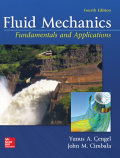
During a hydraulic jump in a wide channel, the flow depth increases from 1.1 to 3.3 in. Determine the velocities and Froude numbers before and after the jump, and the energy dissipation ratio.
The velocity before the jump.
The velocity after the jump.
The Froude number before the jump.
The Froude number after the jump.
The energy dissipation ratio.
Answer to Problem 85P
The velocity before the jump is
The velocity after the jump is
The Froude number before the jump is
The Froude number after the jump is
The energy dissipation ratio is
Explanation of Solution
Given Information:
The flow depth after the jump is
Write the expression for the flow depth after the hydraulic jump.
Here, the Froude number before jump is
Write the expression for the Froude number before jump.
Here, the velocity before the jump is
Write the expression for the average velocity after the hydraulic jump.
Write the expression for the Froude number after jump.
Here, the velocity after the jump is
Write the expression for the head loss associated with the hydraulic jump.
Here, the average velocity before hydraulic jump is
Write the expression for the specific energy of water before the jump.
Write the expression for the dissipation ratio.
Calculation:
Substitute
Substitute
Substitute
Substitute
Substitute
Substitute
Substitute
Conclusion:
The velocity before the jump is
The velocity after the jump is
The Froude number before the jump is
The Froude number after the jump is
The energy dissipation ratio is
Want to see more full solutions like this?
Chapter 13 Solutions
EBK FLUID MECHANICS: FUNDAMENTALS AND A
- A trapezoidal channel has a base width of 8.3 m and side slopes that rise 1 m vertically for every 2 m horizontally. The depth of flow in the channel is 2.7 m, its gradient is 0.001 and the manning’s n is 0.035. Determine the mean velocity in the channelarrow_forwardA channel has a slope of 0.0004 m/m with n=0.015. It is expected that the channel will be able to carry a flow rate of 50 m3/s. Determine the normal depth, critical depth, critical slope,hydraulic radius, top width, velocity head, specific energy and the state of flow if the channel section is trapezoidal and its base width is 3.056 m. The side walls make an angle of 45 with horizontal level. Take ρ=1000 kg/m3 and g = 9.81 m/s2 Froude Number is estimated from F(r^2)=(V^2)T/g(A^3)arrow_forwardA 6m rectangular channel channel carries a discharge of 30 m³/s at a depth of 2.5m. Determine the channel width that produces critical depth.arrow_forward
- Water flowing in a wide channel at a depth of 2 ft and a velocity of 40 ft/s undergoes a hydraulic jump. Determine the flow depth, velocity, and Froude number after the jump, and the head loss associated with the jump.arrow_forwardThe bottom slope of a hydraulically optimum rectangular duct is 0.045 and the Manning friction coefficient is 0.025. If the height of the hydraulic jump formed in this channel is H = 3.5m; How many meters (m) are the energy losses due to the hydraulic jump?arrow_forwardA grass-lined roadside channel (n = 0.02) is triangular in shape with 30° side slopes and a bottom slope of 0.006. Determine the normal depth of flow when the discharge is 4.72 cfs (ft3/sec). Answer:arrow_forward
- Water at 65°F flows at a depth of 1.4 ft with an average velocity of 20 ft/s in a wide rectangular channel. Determine (a) the Froude number, (b) the critical depth, and (c) whether the flow is subcritical or supercritical. What would your response be if the flow depth were 0.2 ftarrow_forwardA rectangular channel has a width of 3 m. If the discharge flowing in the canal is 2.1 m^3/s and coefficient of roughness n = 0.015, compute the critical slope.arrow_forward5A trapezoidal channel carries a discharge of 2.5 m3 /s. Design the section if the slope is 1 in 1200 and the side slopes are 1 in 1. Use Chezy’s formula, C = 55. a. b = 1.154 m; y = 0.577 m b. b = 2.98 m; y = 2.58 m c. b = 0.9 m; y = 1.085 m d. b = 1.872 m; y = 3.12 marrow_forward
- A rectangular channel is 3.0 m wide and carries a discharge of 3.3 m³/s at a depth of 0.9 m. A smooth contraction of the channel width is proposed at a section. Find the smallest contracted width that will not affect the upstream flow conditions. Neglect the energy losses in the transition.arrow_forwardA triangular open-channel (n=0.014) has a side slope of 2H:3V. The flow depth is 2m when the slope is 0.002. Determine the volumetric flowrate.arrow_forwardWater flows uniformly half-full in a 3.2-m-diameter circular channel laid with a slope of 0.004. If the flow rate of water is measured to be 4.5 m3/s, determine the Manning coefficient of the channel and the Froude number.arrow_forward
 Elements Of ElectromagneticsMechanical EngineeringISBN:9780190698614Author:Sadiku, Matthew N. O.Publisher:Oxford University Press
Elements Of ElectromagneticsMechanical EngineeringISBN:9780190698614Author:Sadiku, Matthew N. O.Publisher:Oxford University Press Mechanics of Materials (10th Edition)Mechanical EngineeringISBN:9780134319650Author:Russell C. HibbelerPublisher:PEARSON
Mechanics of Materials (10th Edition)Mechanical EngineeringISBN:9780134319650Author:Russell C. HibbelerPublisher:PEARSON Thermodynamics: An Engineering ApproachMechanical EngineeringISBN:9781259822674Author:Yunus A. Cengel Dr., Michael A. BolesPublisher:McGraw-Hill Education
Thermodynamics: An Engineering ApproachMechanical EngineeringISBN:9781259822674Author:Yunus A. Cengel Dr., Michael A. BolesPublisher:McGraw-Hill Education Control Systems EngineeringMechanical EngineeringISBN:9781118170519Author:Norman S. NisePublisher:WILEY
Control Systems EngineeringMechanical EngineeringISBN:9781118170519Author:Norman S. NisePublisher:WILEY Mechanics of Materials (MindTap Course List)Mechanical EngineeringISBN:9781337093347Author:Barry J. Goodno, James M. GerePublisher:Cengage Learning
Mechanics of Materials (MindTap Course List)Mechanical EngineeringISBN:9781337093347Author:Barry J. Goodno, James M. GerePublisher:Cengage Learning Engineering Mechanics: StaticsMechanical EngineeringISBN:9781118807330Author:James L. Meriam, L. G. Kraige, J. N. BoltonPublisher:WILEY
Engineering Mechanics: StaticsMechanical EngineeringISBN:9781118807330Author:James L. Meriam, L. G. Kraige, J. N. BoltonPublisher:WILEY





